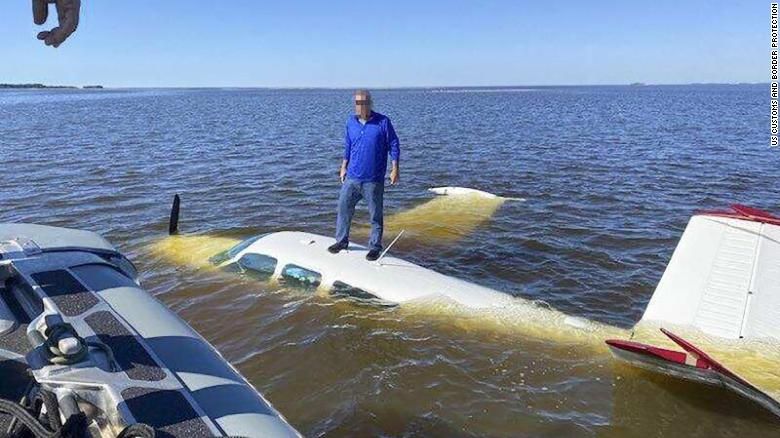Customs and Border Protection (CBP) officers were in the right place at the right time to potentially save a pilot’s life off the coast of Florida on Friday. The federal agents were conducting a “maritime operation” when they came upon a sinking aircraft. “As agents and deputies approached the sinking plane, an individual was spotted climbing out and standing on the fuselage,” said a news release. “Agents verified the pilot was the only occupant and were able to assist him on board an AMO (Air and Marine Operations) Coastal Interceptor Vessel.”
The aircraft ended up in the drink about a half mile offshore from George T. Lewis Airport in Cedar Key, about 100 miles north of Tampa. It’s not clear whether it was taking off or landing. The pilot was OK but was given a medical assessment in the boat. “The situational awareness and quick actions of the Marine Interdiction Agents and Sheriff’s Deputies prevented a possible human tragedy,” said Michael Matthies, Deputy Director of Marine Operations for the CBP. “We are thankful we have the proper resources and trained personnel to perform when incidents like this present themselves.”




































Right place, right time!
That airport has, or had, a sign at the departure point on the runway. It advises the pilot to plan on possible need for attitude indicator use right after departure due to haze and no visual reference ahead as sky and ocean blend into one.
An inflatable vest doesn’t look to be part of his wardrobe that day.
Any crash you can swim away from is a good one…
Marc R.: …providing dry land or an unsubmerged boat is within reach… Where was the life vest on this very lucky pilot? If not already a tithe paying member of a church this guy should join now…
Looks like a well executed ditching.
Actually, the Cedar Key airport isn’t a life vest type airport assuming you aren’t planning to continue out over the Gulf. If you are going to head inland, to the Fla mainland, turning into the downwind after departure puts you over land all the way. Of course, you might have that engine failure immediately after departure. We evaluate that very small risk but think most of us would have gone without vest. .
To all those baffled by this pilot’s lack of a flotation vest, is your aircraft equipped with airbags in case the engine pooches on takeoff from an urban airport? An EPRIB if it should happen in a rural forested area?
Unless you and your aircraft can perform the “Somewhat/Maybe/Possible Turn”, any sort of engine failure after liftoff from the vast majority of GA airports will involve putting it down in a less-than-optimal environment. A body of water is only a relatively rare one of them, and quite preferable to a crowded beach, much less an urban neighborhood. It is literally impossible to equip your airplane for all eventualities. (A helicopter has a few more options, but even so, the thought of auto-rotating into an elementary school playground full of kids, because it’s the only clear spot, affects my pre-takeoff considerations.)
Cedar Key is a small public-use airport on a residential airpark on an tiny island across from a delightful “old Florida” village. Like any seaside airstrip, the winds/weather can make it a challenge, but the decision to land or takeoff is at the pilot’s discretion. An engine failure is not.
It makes no more sense to carry ditching gear for a visit there, than if one were planning a trip to Airventure and just might be directed to depart runway 9 out over Lake Winnebago.
Whatever happened to cause this ditching, the ditching was done as well as it could be done. Even one of the blades exposed above water appears to be straight. Plus, the photo shows an seemingly dry pilot with shoes on standing calmly on top of the airplane awaiting transfer from ship to ship. Great out come for all concerned except one less Bonanza from the fleet including the currently irreplaceable ruddervators it carried to the ocean floor.
Don’t worry, those ruddervators will dissolve before they even hit bottom.
The plane may be resting on the bottom. Its known to be very shallow for a distance along the gulf coast. So if he only a half a mile from shore, it may be resting on the sea floor already!
Was it still floating due to empty fuel tanks?
Back when SEL were RELATIVELY inexpensive (I’m 75) it was a known secret that drug runners would make a soft landing in a pre-arranged off-shore spot, the follow-up crew would take the contraband, and then the plane would be salvaged. Or maybe not, but I heard many rumors, and saw a few news clips about this happening.
Maybe the plane had a major issue and decided to take the insurance money and run.